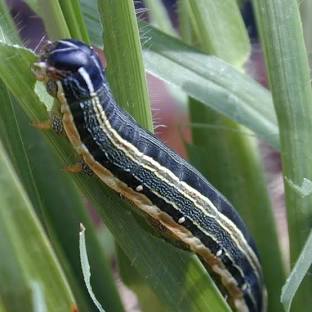
John Cassim
In a concerted effort to combat the most severe African armyworm outbreak in 20 years, Zimbabwe, through the Ministry of Agriculture, Lands, Fisheries, Water and Rural Development, has deployed 214 surveillance traps nationwide. Minister Dr. Anxious Masuka announced this initiative during a Post Cabinet Media Briefing in Harare this Tuesday.
While the primary concern is the African armyworm outbreak, the Fall Armyworm has also been detected in affected areas. Both pests have now been reported in all 10 provinces, spanning 33 districts, prompting the implementation of additional control measures.
“The Ministry of Agriculture, Lands, Fisheries, Water and Rural Development has established 214 surveillance traps to monitor the African Armyworm, currently experiencing its worst outbreak in two decades across the country. All districts now possess chemical reserves for immediate response to this pest,” Dr. Masuka stated.
To ensure timely intervention and enhance preparedness, 60 trucks, one for each district, have been procured. Furthermore, 639,809 knapsack sprayers have been distributed to beneficiaries of the Presidential Input Scheme.
The Presidential input scheme caters for all the small holder farmers, supporting approximately 1.6 million households giving an input pack adequate to cover 0.4 Ha. The main objective of the scheme is to improve food security and reduce poverty in poor rural communities.
Originating in the Americas, the armyworm was first identified in Central and Western Africa in early 2016 and rapidly spread across nearly all of sub-Saharan Africa within two years, according to the United Nations Food and Agriculture Organization (FAO).
These pests, known for their characteristic “marching” behavior, attack young maize plants at their growth points and bore into the cobs.
Reports indicate that climate change, with its increased temperatures and erratic rainfall, is exacerbating the armyworm outbreak.
“We are currently facing outbreaks of both the African and Fall Armyworms. The African armyworm, as is known, is carried by wind currents in the form of moths, which then complete their life cycle upon landing. It is the larval stage that inflicts significant damage on our crops. We have distributed the chemical carbaryl, in its 85WP wettable powder form, to all 60 districts, and we anticipate that all districts will have reserves by the end of the week for immediate spraying,” Dr. Masuka emphasised during the opening of the 2025 Tobacco Auction Season in Harare last week.
“Tobacco farmers and all agricultural stakeholders, please note that the African armyworm is a notifiable pest under our legislation. Report any sightings promptly to the authorities for swift action,” he urged, acknowledging that many tobacco farmers are also maize producers.
Dr. Masuka also cautioned grain dealers against importing from potentially low-cost sources, citing the risk of introducing crop diseases. He explained that the armyworm was first detected in Zimbabwe in 2016, and the Fall Armyworm was initially identified on a farm in imported material.
“We believe the Fall Armyworm was introduced through imported maize, which is why our plant quarantine services have intensified vigilance regarding the sources of imported maize and other grains, particularly during drought years. The temptation to import from the cheapest sources exists, but we must remain vigilant against the potential risks of introducing new diseases. Consequently, we have restricted maize leaf necrosis imports from specific jurisdictions,” he concluded.
